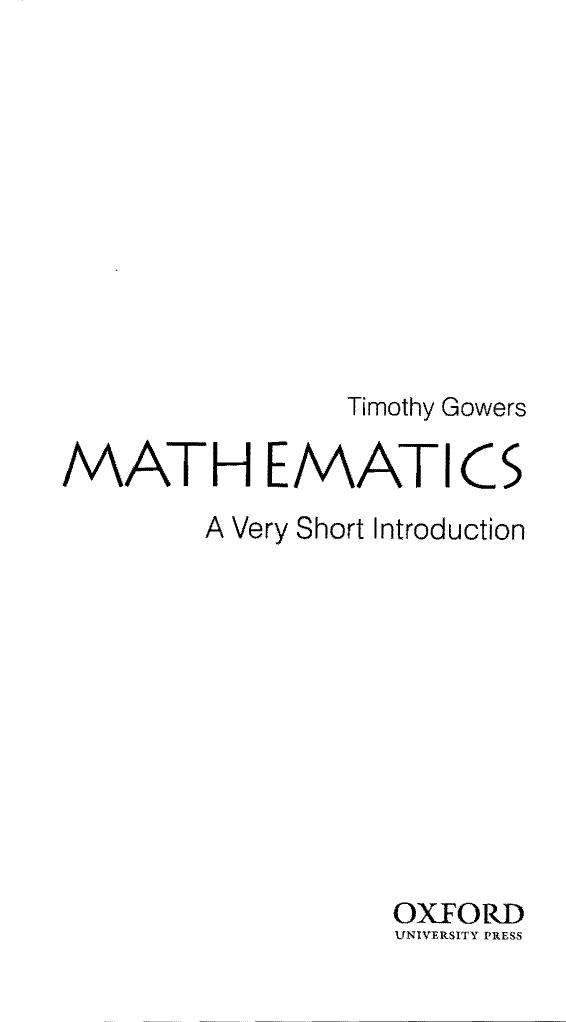Mathematics: A Very Short Introduction by Timothy Gowers

Author:Timothy Gowers
Language: eng
Format: epub, pdf
Publisher: OUP Oxford
Published: 2002-08-14T16:00:00+00:00
2. We reached a speed of 40 m.p.h. just as we passed that lamp-post
Suppose you are in an accelerating car and you have watched the speedometer move steadily from 30 m.p.h. to 50 m.p.h. It is tempting to say that just for an instant – the exact instant at which the arm of the speedometer passed 40 – the car was travelling at 40 m.p.h. Before that instant it was slower and afterwards it was faster. But what does it mean to say that the speed of a car is 40 m.p.h. just for an instant? If a car is not accelerating, then we can measure how many miles it goes in an hour, and that gives us its speed. (Alternatively, and more practically, we can see how far it goes in 30 seconds and multiply by 120.) However, this method obviously does not work with an accelerating car: if one measures how far it has gone in a certain time, all one can calculate is the average speed during that time, which does not tell us the speed at any given moment.
The problem would disappear if we could measure how far the car travelled during an infinitely small period of time, because then the speed would not have time to change. If the period of time lasted for t hours, where t was some infinitely small number, then we would measure how many miles the car travelled during those t hours, take our answer s, which would also be infinitely small of course, and divide it by t to obtain the instantaneous speed of the car.
This ridiculous fantasy leads to problems very similar to those encountered when we briefly entertained the idea that one point nine recurring might not equal two. Is t zero? If so, then quite clearly s must be as well (a car cannot travel any distance in no time at all). But one cannot divide zero by zero and obtain an unambiguous answer. On the other hand, if t is not zero, then the car accelerates during those t hours and the measurement is invalid.
The way to understand instantaneous speed is to exploit the fact that the car does not have time to accelerate very much if t is very small – say a hundredth of a second. Suppose for a moment that we do not try to calculate the speed exactly, but settle instead for a good estimate. Then, if our measuring devices are accurate, we can see how far the car goes in a hundredth of a second, and multiply that distance by the number of hundredths of a second in an hour, or 360,000. The answer will not be quite right, but since the car cannot accelerate much in a hundredth of a second it will give us a close approximation.
This situation is reminiscent of the fact that 1.41421352 is a close approximation to 2, and it allows us to avoid worrying about the infinite, or in this case infinitely small, in a very similar way.
Download
Mathematics: A Very Short Introduction by Timothy Gowers.pdf
This site does not store any files on its server. We only index and link to content provided by other sites. Please contact the content providers to delete copyright contents if any and email us, we'll remove relevant links or contents immediately.
| Applied | Geometry & Topology |
| History | Infinity |
| Mathematical Analysis | Matrices |
| Number Systems | Popular & Elementary |
| Pure Mathematics | Reference |
| Research | Study & Teaching |
| Transformations | Trigonometry |
Modelling of Convective Heat and Mass Transfer in Rotating Flows by Igor V. Shevchuk(6408)
Weapons of Math Destruction by Cathy O'Neil(6220)
Factfulness: Ten Reasons We're Wrong About the World – and Why Things Are Better Than You Think by Hans Rosling(4715)
A Mind For Numbers: How to Excel at Math and Science (Even If You Flunked Algebra) by Barbara Oakley(3262)
Descartes' Error by Antonio Damasio(3250)
Factfulness_Ten Reasons We're Wrong About the World_and Why Things Are Better Than You Think by Hans Rosling(3218)
TCP IP by Todd Lammle(3158)
Fooled by Randomness: The Hidden Role of Chance in Life and in the Markets by Nassim Nicholas Taleb(3083)
Applied Predictive Modeling by Max Kuhn & Kjell Johnson(3043)
The Tyranny of Metrics by Jerry Z. Muller(3032)
The Book of Numbers by Peter Bentley(2935)
The Great Unknown by Marcus du Sautoy(2664)
Once Upon an Algorithm by Martin Erwig(2625)
Easy Algebra Step-by-Step by Sandra Luna McCune(2607)
Lady Luck by Kristen Ashley(2556)
Police Exams Prep 2018-2019 by Kaplan Test Prep(2517)
Practical Guide To Principal Component Methods in R (Multivariate Analysis Book 2) by Alboukadel Kassambara(2515)
All Things Reconsidered by Bill Thompson III(2374)
Linear Time-Invariant Systems, Behaviors and Modules by Ulrich Oberst & Martin Scheicher & Ingrid Scheicher(2348)
